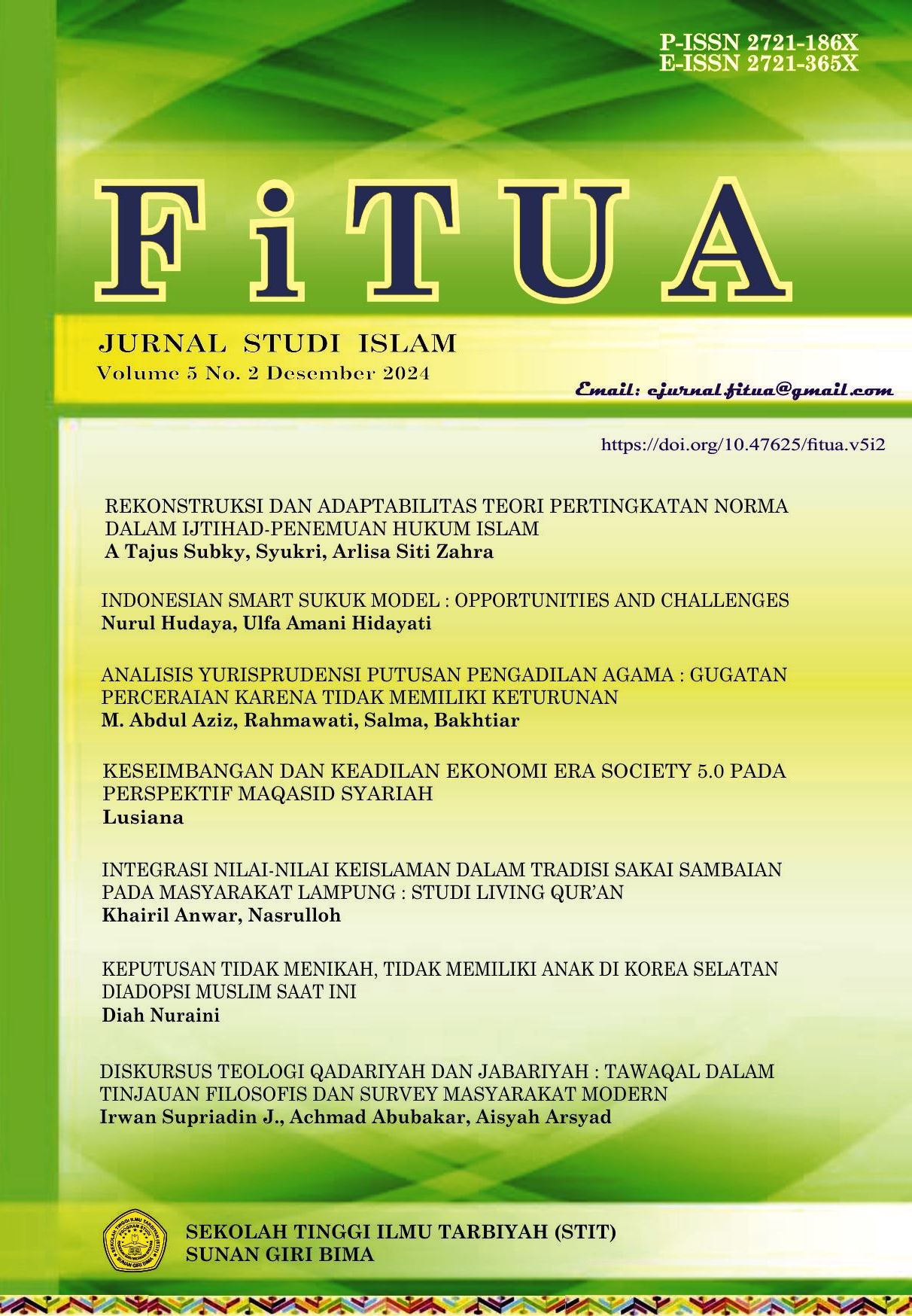The Development of Rimpu Culture in the Face of Modernization and Globalization (A Study Using Phenomenological Approach)
Abstract
This research aims to describe the development of rimpu culture in the face of modernization and globalization in the lives of Bima people, identify the impact of the decline of rimpu culture in the midst of waves of modernization and globalization, describe the efforts of the community and government in preserving rimpu culture. This research uses qualitative research methods. This research method will describe how the views of the figures about the development of rimpu facing modernization and globalization. The type of research used is descriptive phenomenological. The source of research data consists of cultural figures, academics consisting of the head of the Dikpora office and the head of the tourism office, as well as religious leaders collecting data with qualitative research, namely observation, interviews, and documentation. The results showed that the development of rimpu culture in Bima began when Islam became the religion of the Bima people. The impact of the decline of rimpu culture is the shift in the values of the meaning of the motto maja labo dahu. Some of the things done by the government and the community to preserve rimpu culture are conducting rimpu festival activities, cultural parades, karnafal, and using rimpu in the school environment.
Downloads
References
Anhar, A. S., Nini, R., & Muslimin, M. (2024). Pendidikan Karakter pada Anak Usia Dini Berbasis Budaya Lokal Maja Labo Dahu. Jurnal Pelita PAUD, 9(1), 86–95.
Aulia, R. N. (2013a). Rimpu: Budaya Dalam Dimensi Busana Bercadar Perempuan Bima. Jurnal Studi Al-Qur’an, 9(2), 94–108.
Aulia, R. N. (2013b). Rimpu: Budaya Dalam Dimensi Busana Bercadar Perempuan Bima. Jurnal Studi Al-Qur’an, 9(2), 94–108.
Budiono, M. (2017). Tangguh Bersama, Jepretan Lensa dan Catatan Sederhana Pekerja Terminal BBM Tentang Bencana Banjir Bandang Kota Bima. Jakarta: PT. Elex Media Komputindo, Kelompok Gramedia. hlm. 16.
Darmurtika, L. A., Juriati, A., Nuranisah, N., Fadila, U., Bujang, A., & Alfatih, M. D. (2025). Rimpu dan Identitas Perempuan Bima: Tinjauan Semiotik atas Nilai Kesopanan. Jurnal Ilmiah Telaah, 10(2), 69–74.
Durkheim, E. (1973). Forms of the religious life. Durkheim, on Morality and Society. Chicago: University of Chicago Press.(Orig. Pub. 1912.), 269–297.
Durkheim, E. (2016). The elementary forms of religious life. In Social theory re-wired (pp. 52–67). Routledge. https://api.taylorfrancis.com/content/chapters/edit/download?identifierName=doi&identifierValue=10.4324/9781315775357-6&type=chapterpdf
Fadilah, D., & Ula, D. M. (2024). Teori Sosiologi Dan Karya Max Weber. Triwikrama: Jurnal Ilmu Sosial, 3(12), 34–46.
Geertz, C. (1973). The interpretation of cultures New York. NY: Basic Books.
Geertz, C. (2013). Religion as a cultural system. In Anthropological approaches to the study of religion (pp. 1–46). Routledge. https://api.taylorfrancis.com/content/chapters/edit/download?identifierName=doi&identifierValue=10.4324/9781315017570-1&type=chapterpdf
Hasan Basri. (2018). Keterampilan Abad 21 dalam Pendidikan. Ar-Ruz Media.
Irfan, M. (2022). Perkembangan Budaya Rimpu Dalam Menghadapi Modernisasi Dan Globalisasi (Studi Dengan Menggunakan Pendekatan Fenomenologi). Fikroh Jurnal Studi Islam, 6(2), 163–173.
Iskandar. (2009). Iskandar. Metodologi Penelitian Pendidikan Dan Sosial. (Jakarta. GP Press, 2009), hal 204. GP Press.
Ismail, M. H. (1996). Sejarah Mbojo Bima. Mataram. Agung Perdana.
Ismail, M. H. (2005). Sejarah Kebudayan Masyarakart Bima. Mataram: Lengge Press.
Ismail, M. H., & Malingi, A. (2018). Jejak Para Sultan Bima. CV Adnan Printing.
Karangan, B. B.-K. (1997). Koentjaraningrat, Pengantar Ilmu Antropologi, Jakarta: Aksara Baru, 1986. Kobong Theodorus, Injil Dan Tongkonan, BPK Gunung Mulia, Jakarta.
Rachman, M. F. (2008). Islam di Bima: Kajian historis tentang proses Islamisasi dan perkembangannya sampai masa kesultanan. Genta Press.
Rahmi, R. (2022a). MAKNA RIMPU SEBAGAI MEDIA KOMUNIKASI NONVERBAL BAGI PEREMPUAN BIMA. Jurnal Komunikasi Dan Kebudayaan, 9(1), 69–79.
Rahmi, R. (2022b). MAKNA RIMPU SEBAGAI MEDIA KOMUNIKASI NONVERBAL BAGI PEREMPUAN BIMA. Jurnal Komunikasi Dan Kebudayaan, 9(1), 69–79.
Rusmini, A. (2023). Peran Masyarakat Sosial dalam Agama Perspektif Max Weber dan Relevansinya Kemajuan Masyarakat. Jurnal Filsafat Indonesia, 6(2), 189–196.
Rutherford, J. (1990). Identity: Community, culture, difference. Lawrence & Wishart. https://muse.jhu.edu/book/34784.
Salam, A. (2022). Karakter Maja Labo Dahu Dalam Perspektif Pendidikan Islam Di Bima. Fitrah: Jurnal Studi Pendidikan, 13(2), 98–106.
SARI, W. M. (2021). Pengaruh modernisasi terhadap kearifan lokal. Studi Pustaka, 9(4).
Soekanto, S. (1990). Sosiologi Suatu Pengantar, Jakarta: Rajawali Pers. Susilo, Rakhmad K. Dwi (2008). Sosiologi Lingkungan, Jakarta: Rajawali Pers.
Sugiyono. (2008). Metode Penelitian Pendidikan (Pendekatan Kuantitatif, Kualitatif, dan R & D). Alfabeta.
Tylor, E. B. (1871). Primitive culture: Researches into the development of mythology, philosophy, religion, art, and custom (Vol. 2). J. Murray. https://books.google.com/books?hl=id&lr=&id=RUMBAAAAQAAJ&oi=fnd&pg=PA40&dq=Tylor,+E.+B.+(1871).+Primitive+Culture.+London:+John+Murray.&ots=X-s0euMWbT&sig=rpHSzt9TmYo65CPoeBcEEi87f-g
Umar, M. P. I., & Sukrin, H. T. (2021). Etnopedagogi maja labo dahu. Pustaka Pencerah. https://books.google.com/books?hl=id&lr=&id=NbYOEQAAQBAJ&oi=fnd&pg=PP1&dq=Studi+Etnografi+Pembentukan+Karakter+Anak+Melalui+Budaya+Maja+Labo+Dahu+Masyarakat+Bima.+2009%C3%B9&ots=CgN59ytNsM&sig=0DiPJMn-esMZU9GYti571zWYWg4
Copyright (c) 2024 Muhammad Irfan

This work is licensed under a Creative Commons Attribution-ShareAlike 4.0 International License.









